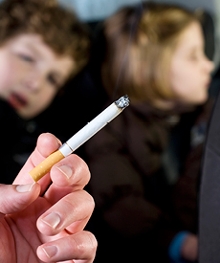
How unsafe is it for children when there is a smoker in the house? Home is the No. 1 place for secondhand smoke exposure for children and nonsmokers, says Michelle Kegler, director of the Emory Prevention Research Center and professor of behavioral sciences and health education at Rollins. Secondhand smoke, she adds, is linked to worsening asthma and lower respiratory tract infections in children.
According to the CDC, approximately 18% of American adults smoke despite health warnings and a public that is generally scornful of smokers. Most smokers report trying to quit multiple times. How to effectively help them quit is a vexing public health problem, compounded by the fact that adults often smoke at home with children present.
Kegler, along with colleagues Carla Berg, Regine Haardörfer, and Cam Escoffery, worked with the United Way of Greater Atlanta to recruit smoking households to participate in a project to create home smoking bans. Families who called United Way’s 2-1-1 helpline and had at least one smoker in the home enrolled voluntarily in the study. They received three mailings and one coaching phone call to help them develop a "no-smoking" zone inside the home.
"Many of these families have children, and this is one way of protecting them," Kegler says. "We are reinforcing a norm that smoking is bad for health. This program is another social force to discourage smoking."
Kegler sees the program’s structure as key to its potential success. There are no long counseling sessions to attend, and the smoker is not being asked to quit. "It’s a quick and easy intervention," she says of the program now being tested in North Carolina and Texas.
In the study’s first group of 498 households with smokers, 100% allowed smoking inside the home at the beginning of the program. At the program’s completion, 40% had totally banned smoking inside, compared with 25% of the control group. Smokers reported smoking fewer cigarettes per day. Because the intervention was successful, fewer children and nonsmoking adults will be exposed to secondhand smoke, and more smokers may be on the path to quitting.
Kegler agrees that current anti-smoking measures are working, particularly cigarette taxes, which have been shown to prevent young people from smoking. While cessation programs are valuable for current smokers, she says, public health interventions have changed social norms around smoking and prevented many people from taking that first puff.
